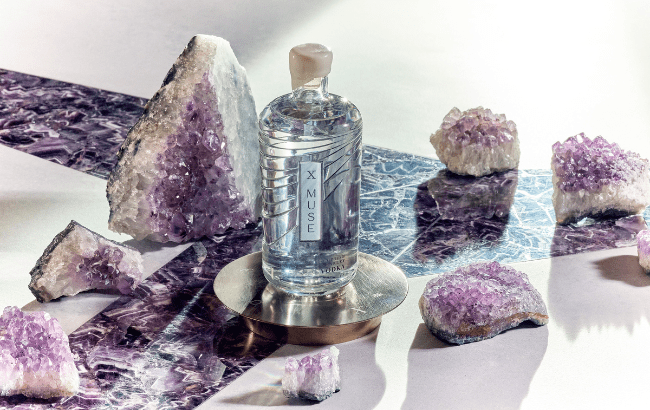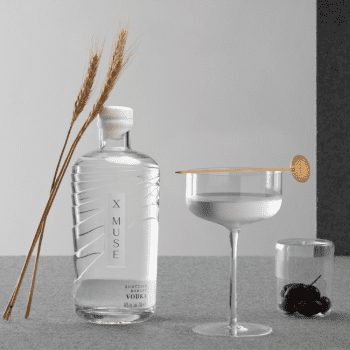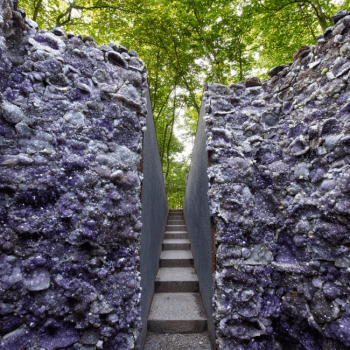X Muse ‘reawakens’ vodka innovation
By taking inspiration from Scottish production methods and fusing them with art and culture, X Muse has created a vodka that has ‘reawakened’ innovation within the category, co-founder Vadim Grigoryan tells us.

After starting his career as a rocket scientist, Grigoryan went on to spend 15 years at Pernod Ricard, starting as marketing director for Russia and Eastern Europe, repositioning Ararat, Chivas Regal, Olmeca, Perrier-Jouët and Martell through a series of repackaging, rebranding, events, and experiences that he creatively directed, before becoming the French firm’s international director of creativity and luxury.
In that time, he was responsible for re-establishing Absolut’s art programme with innovative collaborations involving leading artists. He also became the London-based brand director for Royal Salute, overseeing the repositioning of the luxury whisky blend using the same model.
In 2018, Grigoryan became the founder and artistic brand director of X Muse (pronounced Tenth Muse) – a brand he ‘created from scratch’ alongside Robert Wilson, co-creator of Jupiter Artland and co-owner of leading natural medicine manufacturer, Nelsons.

As Grigoryan prepares to publish his book, Art Thinking, in 2025, he explains how the brand has been designed to reflect his philosophies on art. “The book is a certain kind of philosophy about how to engage with the world of art, and X Muse is the brand that exhibits that in the best possible way.
“Unlike many people that talk about some ideas, where it stays as ideas, I tried to put my money where my mouth is,” he says, noting that X Muse is “a brand of a new generation”.
“That’s how we conceived the brand,” he continues. “It’s really looking into the new paradigm – the changing relationship with consumers – and I think really trying to present not just a vodka, but a brand with meaning.”
The brand’s name is drawn from the Xth Muse bust of Sappho by Scottish poet, artist and gardener Ian Hamilton Finlay, which resides at the Jupiter Artland gallery set in the grounds of Bonnington House outside Edinburgh. It boasts a blend of two heritage barley varieties, which Grigoryan notes is usually more typical of Scotch whisky, and pure water drawn from the Jupiter Artland estate.
He explains: “We have several layers of innovation within the vodka. Quite often people ask: ‘why vodka?’, and I think that vodka has been a very silent category in terms of innovations. I mean, fundamentally, if you look at the timeline of ‘big bangs’ in vodka’s history, you would have probably three major ones,” he says.
Vodka’s ‘big bangs’
The first of these ‘big bangs’, Grigoryan says, was the introduction of the premium concept to the category by Stolichnaya in the 1960s, when it was considered to be one of the more expensive vodka brands on the market. It then went on to become the first premium vodka to be imported into the US in the 1970s.
Grigoryan cites the introduction of a “very different style of marketing” brought forward by Absolut as the second turning point in the category’s history, in which the brand engaged with culture to deliver a new dimension to the category. “I think in general, Pernod Ricard has been very good with cultural marketing,” he adds, referencing Havana Club’s engagement with Cuban music, and Jameson’s involvement with art house short film festivals.

The final key moment for the vodka category by which he was inspired, he says, was the approach taken by Bacardi-owned Grey Goose to draw influence from brown spirits, as seen by its nod to Cognac. “It was a revolutionary idea at the time, and I think it really paid out well.” However, since then he says “there has been a lot of dormancy. Yes, there were brands appearing, there was some big change in the vodka industry with celebrities being brought to vodka brands, but fundamentally, there was nothing new.”
The latency of innovation, twinned with these three pivotal moments in the category’s history, are what inspired Grigoryan to create X Muse.
“What we tried to do is also to take these two last innovations, one from Absolut and one from Grey Goose, and put them together almost like in Steve Jobs stunt of creating iPhone, because, as you know, there was absolutely zero fundamental innovation in the iPhone – what he created was bringing some existing technologies together.”
He continues: “I think that we tried to get the strength of some of the innovations of the industry, recombine them in different way, but also push it to a completely different level of execution in terms of the quality and thinking behind the packaging, behind the product, and everything is done with a certain meaning behind it. And that’s why, when I say would like to create a meaningful brand, it’s not just blah, blah, blah. We really tried to create a brand similar to a multi-storey building, where each floor leads to another floor, or each door leads to another door.”
Preoccupation with taste
By taking inspiration from the Grey Goose school of thought, Grigoryan says X Muse looked to “create a little revolution by being inspired by the Scottish tradition of spirit making”. However, he says, the approach was “more inspired” than Grey Goose, which, he says, would have used grapes had it been a purist to its Cognac roots. “We took barley as our main material, and we pushed it further, because we said we’re going to take not just any barley, but we would try to find particular varieties of barley. And that is quite a new thing in the Scottish spirits making tradition. In vodka, if you ask producers the variety of their grain, 99.99% would say they don’t know, because the industry has been focused on efficiency and yield. However, we were preoccupied with taste.”
The intention for the spirit, Grigoryan says, was to make a product that can be enjoyed neat as well as mixed in cocktails. “We created this little innovation because we wanted to create a sipping vodka, but at the same time we wanted to keep the mixability, so it’s almost like an oxymoron, right? How you can keep the two together?” He explains that this was a big challenge for the brand, and took three years to achieve the desired results, aided by a partnership with Heriot-Watt University.

With taste as a priority, X Muse was created using two varieties of heritage barley that are prized for their flavour: Maris Otter and Plumage Archer. These were both distilled separately and combined in precise quantities. In addition, the water used in both the distillation and dilution stage of production was sourced from the aquifer that is framed by artwork by Charles Jencks on the Jupiter Artland estate.
The resulting vodka is described as very smooth, with notes of pears, and caramelised apple pie “purely from the grain”.
Grigoryan also notes that the brand has “an esoteric level”, on account of the liquid from the distillation process resting on amethyst crystals, linking to natural energetic healing and in reference to British artist Anya Gallaccio’s amethyst grotto, also on view at the Jupiter Artland estate.
“We believe that it makes our vodka – on an energetic level – a more positive product,” he explains, noting that while that is the brand’s belief, the marketing does not impose that thinking. “We actually don’t talk much about that. You will never find us on the packaging or whatever. But our slogan is ‘Plura Latent, Quam Patent’, which means ‘more is hidden than uttered’. So the whole brand ethos is about these invisible elements, such as the barley variety, that is invisible to most of the people, but it has an impact.”
Grigoryan explains that the intention was not to “over-intellectualise the brand” but rather give consumers the opportunity to either simply enjoy the vodka and its packaging as a premium product, or, if they want, dive deeper into the brand’s story and philosophy. This includes exploring the inspiration from figures like Ian Hamilton Finlay, as well as the brand’s connection to alchemy and its impact on the product conception.
It is the flexibility to both enjoy X Muse on a surface level or explore its deeper meanings that forms a foundation of the brand’s strategy to connect with the premium vodka market.
X Muse is priced at £55 (US$70) per 700ml and is available from the X Muse website and at Harvey Nichols, Selfridges, Hedonism, Fortnum & Mason, Petersham Cellar, Master of Malt, Amazon UK and The Whisky Exchange.
It is also listed in more than 100 bars across London and Edinburgh, and is exported to France in partnership with La Maison du Whisky.
Related news
Sexy Fish launches premium vodka
